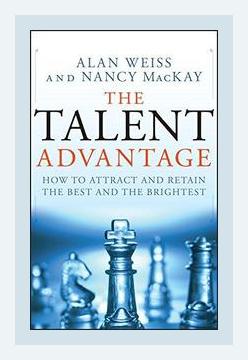Human Resources and Talent ManagementRecruitment and Hiring
“The Talent Advantage: How to Attract and Retain the Best and the Brightest” by Alan Weiss and Nancy MacKay is a comprehensive guide aimed at organizations seeking to recruit and maintain top talent. The book was published in 2009 and falls within the categories of Recruitment and Hiring. It provides practical strategies and insights into creating a talent-centric organization. Below is a detailed summary, structured around major points, complete with examples and actionable steps.
Introduction
Overview
Weiss and MacKay emphasize the importance of having a talented workforce in achieving organizational success. In a competitive marketplace, the ability to attract and retain the best and brightest employees is crucial.
Actionable Step:
- Assessment of Current Talent Pool: Conduct an internal audit to assess the quality and capabilities of current employees. Identify gaps and areas that require improvement.
Chapter 1: Understanding Talent
Key Point: Definition of Talent
The authors define talent as the natural ability, commitment, and motivation to perform at a high level. Talent goes beyond skills or knowledge; it includes attributes like adaptability, creativity, and a passion for work.
Example:
- Google’s hiring policy values cognitive ability and leadership over specific technical skills.
Actionable Step:
- Profile Ideal Candidates: Create detailed profiles of what constitutes ‘talent’ in your specific industry, focusing on both hard and soft skills.
Chapter 2: Building a Talent-Oriented Culture
Key Point: Organizational Culture
A talent-oriented culture attracts high performers. Organizations should instill values that support learning, innovation, and performance.
Example:
- Zappos offers new employees $2,000 to quit after their first week to ensure that only those who are truly committed stay.
Actionable Step:
- Cultural Audit: Evaluate your company’s culture and identify areas where it can be more supportive of talent development. Implement changes that promote a positive, growth-oriented environment.
Chapter 3: Talent Acquisition
Key Point: Recruitment Strategy
Weiss and MacKay stress the importance of a strategic approach to recruitment, aligning it with business goals. Companies should invest in employer branding to attract top talent.
Example:
- Microsoft’s internships and partnerships with universities to scout young, talented individuals.
Actionable Step:
- Employer Branding Campaign: Develop and implement a branding campaign that highlights your company’s unique selling propositions to potential employees.
Chapter 4: Selection Process
Key Point: Effective Selection
The book emphasizes the need for a rigorous selection process. This includes structured interviews, personality assessments, and realistic job previews.
Example:
- Southwest Airlines uses behavioral interviewing techniques to ensure candidates fit their customer service-oriented culture.
Actionable Step:
- Structured Interview Guides: Develop structured interview guides that include behavioral questions and situational tests aligned with the company’s values and the role’s requirements.
Chapter 5: Onboarding
Key Point: Successful Onboarding
A strong onboarding process is crucial for retention. It should deliver a welcoming experience, clarify roles and responsibilities, and foster relationships.
Example:
- IBM’s “Assimilation Breakthrough” program that helps new hires connect with mentors and learn about the company’s culture.
Actionable Step:
- Onboarding Program: Implement a comprehensive onboarding program that includes mentorship, regular check-ins, and opportunities for new employees to integrate socially and professionally.
Chapter 6: Talent Development
Key Point: Continuous Development
Talented employees seek continuous learning and development opportunities. Offering professional development not only enhances their skills but also increases their loyalty to the company.
Example:
- General Electric’s (GE) Crotonville campus, which offers leadership and skills development programs.
Actionable Step:
- Development Plans: Create individualized development plans for employees that include training, career paths, and growth opportunities.
Chapter 7: Performance Management
Key Point: Performance Evaluations
Effective performance management involves regular feedback, goal setting, and clear metrics for success. It’s not just annual reviews but ongoing support and evaluation.
Example:
- Accenture’s shift from annual performance reviews to a more continuous feedback model.
Actionable Step:
- Continuous Feedback Systems: Implement a performance management system that encourages regular feedback, including quarterly review meetings.
Chapter 8: Retention Strategies
Key Point: Engaging and Retaining Talent
Retention strategies should focus on engagement, competitive compensation, work-life balance, and recognition.
Example:
- Google’s extensive perks and benefits package, which includes free meals, fitness centers, and generous leave policies.
Actionable Step:
- Employee Engagement Programs: Develop programs and initiatives designed to recognize achievements, support work-life balance, and engage employees in meaningful ways.
Chapter 9: Succession Planning
Key Point: Future-Proofing Talent Pipelines
Succession planning ensures that there are capable employees ready to take on key roles as they become available.
Example:
- Procter & Gamble (P&G) focuses heavily on succession planning, promoting from within and developing leaders internally.
Actionable Step:
- Succession Plans: Create succession plans for key positions, identifying potential future leaders and outlining their development paths.
Chapter 10: Leadership’s Role
Key Point: Leadership Commitment
The leadership team must be committed to fostering and maintaining talent. Their actions and behaviors set the tone for the entire organization.
Example:
- Starbucks CEO Howard Schultz’s focus on employee welfare and development.
Actionable Step:
- Leadership Training: Provide training and resources for leaders to improve their talent management skills and emphasize the importance of talent-focused strategies.
Conclusion
Summary
“The Talent Advantage” concludes that attracting and retaining talent is an ongoing process requiring a holistic approach. Companies that prioritize their employees, offering a supportive culture, development opportunities, and consistent recognition, will naturally attract and retain the best and the brightest.
Final Actionable Step:
- Continuous Improvement: Regularly revisit and refine your talent management strategies, using feedback from employees and evolving best practices to stay competitive.
By implementing these strategies and following the actionable steps provided, organizations can significantly enhance their ability to attract, retain, and develop top talent, driving greater success and sustained growth.
